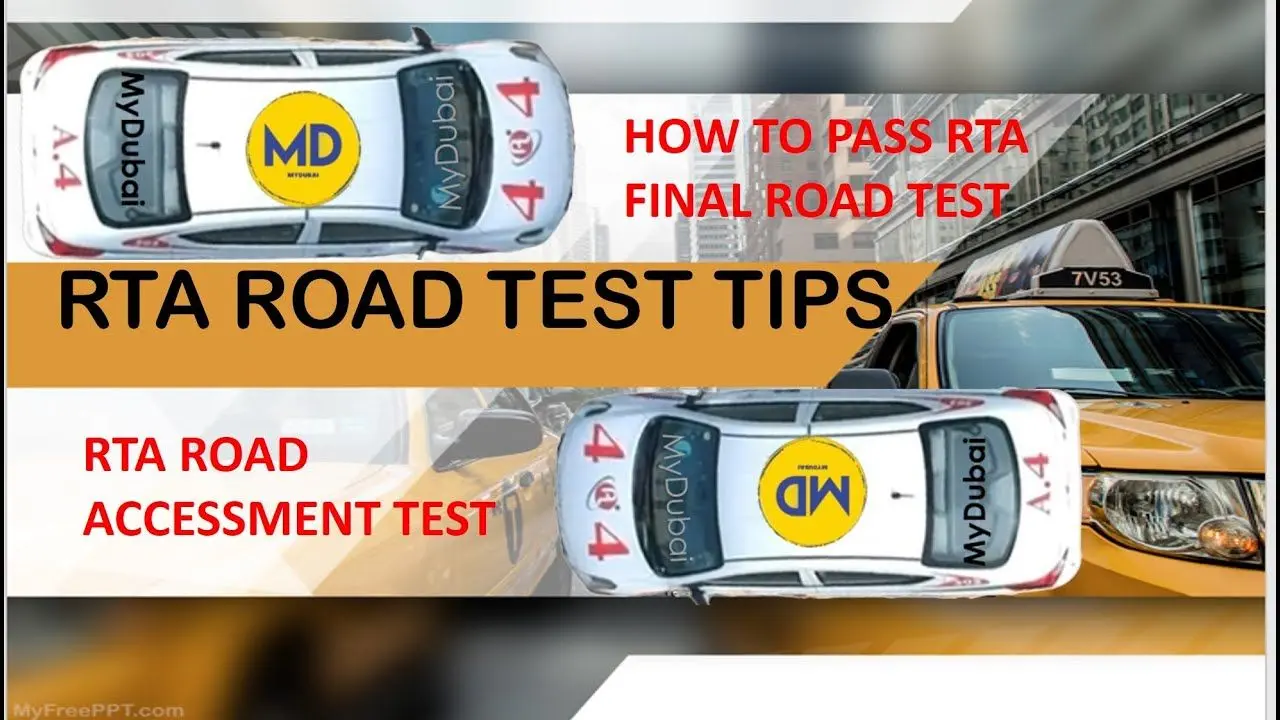How to Pass Your RTA Road Test in Dubai: Ultimate Guide & Tips

Key takeaways
- What to Expect on Your RTA Final Road Test: Format & Duration
- RTA Road Test Score Sheet: How Points & Major Mistakes Work
- The Ultimate RTA Road Test Checklist: Before You Start the Car
- Top RTA Road Test Tips: How to Pass on Your First Try
- Automatic Fail: The Most Common Major Mistakes to Avoid
- How to Pass the RTA Parking Test: Tips for Each Parking Type
- Before the Final Test: Understanding the Initial Assessment
- FAQ
We know how you feel: the RTA final road test is your last major hurdle before being able to drive across amazing Dubai. For many, it's a source of considerable anxiety. Passing the driver’s test might sound difficult, but keep in mind that you can definitely pass it, even on the first attempt, with sufficient preparation. Simply knowing how to drive is not enough; you need to convince the examiner that you are a capable driver. Think of this guide as your personal co-pilot. We will take you through everything you need to know on how to pass driving test in Dubai, from the pre-test checklist to the common mistakes and essential tips.
What to Expect on Your RTA Final Road Test: Format & Duration

The best way to beat the butterflies is by knowing what to expect. The RTA final road test Dubai is an easy test of your practical driving skills. The test is not designed to catch you out; it is designed to ensure you are able to drive safely and legally in the UAE.
Here's a typical timeline of the exam:
- You will be called along with a few other candidates. The examiner will greet you, check your documents, and assign you a car to drive.
- Once you get into the driver’s seat, you get your first chance to shine! It is essential that you carry out some checks before starting; these are given in the checklist below.
- The examiner will give you clear verbal instructions (for example, "take the next right," "change to the left lane," "park behind that car"). The route will likely encompass roundabouts, highways, and residential streets.
- While taking the test, the examiner will ask you to do some maneuvers like parking.
- The entire process takes around 10-20 minutes. At the end, the examiner will inform you of the result.
The entire process is professional and structured. You want to show that you’re a safe driver who pays attention.
RTA Road Test Score Sheet: How Points & Major Mistakes Work

Understanding the scoring system is crucial. Even if a few minor mistakes are made, a candidate can pass as per the RTA's system, but a critical error will result in a fail.
- An example of a minor fault would be hesitating at the stop line. You are allowed to make up to 12 minor mistakes. Accumulating 13 or more will result in a fail.
- When a road test candidate performs an action that is dangerous or illegal, it is called an RTA road test major mistakes. One such mistake will get you an automatic fail.
Here are examples of each to give you a clear idea.
Major Mistakes (Instant Fail):
- Running a red light or a stop sign
- Causing another vehicle to brake or swerve sharply
- Driving into the wrong lane from a roundabout
- Hitting the curb forcefully during parking
- Exceeding the speed limit significantly
- An unsafe lane change causing danger
Minor Mistakes (Points Accumulated):
- Hesitation when it’s safe to proceed
- Forgetting to check mirrors before signaling
- Not using the handbrake when stopping on a hill
- Stalling the engine once
- Steering with one hand for an extended period
- Braking too harshly without reason
Understanding the difference makes it easy to know what to focus on during your test.
The Ultimate RTA Road Test Checklist: Before You Start the Car

Your test begins the moment you sit in the driver's seat. The RTA road test checklist below shows the examiner that you are a careful driver who takes safety seriously, even before starting the engine.
- Close the door properly.
- Adjust your seat to make it easier to reach the pedals and to get a better view of the road.
- Make sure your rearview and both side mirrors are adjusted.
- Fasten your seatbelt. You must wait for the examiner and any other candidates to put theirs on. Do not start moving until everyone is belted in.
- Make sure you apply the handbrake and put the gear in the "P" (Park) or "N" (Neutral) position.
You will create a good impression by doing these steps calmly and drive confidently.
Top RTA Road Test Tips: How to Pass on Your First Try

Check out these Dubai road test tips that will help you pass on your first attempt.
During the Drive: Steering, Lane Control, and Observation
- Most experts say you should keep both hands on the wheel in the “9 and 3” or “10 and 2” position.
- Make sure to stay in your lane at all times. Do not drift towards the lines.
- Make your observations obvious. Move your head when checking mirrors and blind spots. The examiner needs to see you being aware. Glance at your rearview mirror every 8-10 seconds.
- Gently use the accelerator and brake pedals. Jerky movements suggest a lack of control.
- Always maintain a safe distance from the vehicle in front of you (the "3-second rule" is a safe distance).
How to Handle Highways and Change Lanes Safely
- To match the speed of the fast-moving traffic on a highway, use the entrance ramp to accelerate. Use your signal, check the mirrors and blind spot, and merge only when it is safe to do so.
- Whenever you change lanes, always remember MSM: Mirror (check your rearview and side mirror), Signal (indicate your intention), and Maneuver (only after a final head-check of your blind spot by turning your head).
- Don’t drive under the speed limit, but don’t exceed it either. Drive “within” the limit. Driving too slowly on the highway is just as unsafe as driving too fast.
Automatic Fail: The Most Common Major Mistakes to Avoid

To ensure you pass your RTA road test Dubai, avoid these instant-fail mistakes:
- Failing to Stop at a Stop Sign: When you arrive at a stop sign, you must come to a full stop behind the line. You cannot do a rolling stop.
- Examiner Intervention: If the examiner has to take the steering wheel or use the brake, the driver will fail the exam.
- Endangering Others: Forcing another car to brake suddenly or swerve.
- Striking the Curb with Force When Parking.
- Unsafe Roundabout Entry: Not giving way to cars already in the roundabout.
- Ignoring Traffic Signals: Failing to stop at a red signal, or at a yellow one when it was reasonably safe to do so.
How to Pass the RTA Parking Test: Tips for Each Parking Type

The parking test is a key part of the exam. The best advice we can give is to observe your surroundings using your mirrors. The reversing camera is great for support, but you should rely on your mirrors and awareness in your driving skills test.
Parallel Parking (90-Degree Parking)
The RTA often refers to this parking type as 90-degree or angle parking, not parallel parking, which you may be thinking of.
- When you get close to the car you want to park next to, leave about a meter of space.
- Slowly reverse your car until your rear bumper and the neighboring car’s rear bumper align.
- Turn the steering wheel fully towards the parking spot.
- When your car is in the bay, straighten the steering wheel and continue reversing until you are in the lines.
Garage Parking (Parking in a Bay)
- Approach by getting your car perpendicular to the parking bay.
- Make use of your side mirrors to measure the distance from the white lines on either side.
- Take your time as you reverse into the bay, steering slightly to keep the car centered.
- Your car should stop fully in the bay without any contact with the curb at the back.
Before the Final Test: Understanding the Initial Assessment

To schedule your final RTA road test, you must first pass an initial driving assessment test at your driving school. This is not the official RTA test. A senior instructor from your institution will conduct a test to check your driving skills to see whether you will be able to pass the actual test. This ensures that you are prepared and have a good chance of success, so you do not waste your money and time on the official exam.
Here are our answers to a few final, common questions.
FAQ
How many major mistakes can I make?
You cannot make any. With any of these major mistakes, you will fail the road test on the spot.
Can I use my instructor's car for the test?
No, you will take your final road test in a vehicle assigned by the RTA. The car will be a regular sedan with an automatic transmission, like those in Dubai driving schools.
What happens if I fail? How soon can I retake it?
If you fail, don't worry—it's very common. The examiner will give you a report of your mistakes. In order to book a new test date, you must take at least 8 more training classes at your driving school. The waiting period for a new test can vary.
Recent Articles
- Best Afternoon Tea in Dubai
- Quranic Park Dubai: A Visitor’s Guide to Faith and Nature
- Dubai Shopping Festival 2025-2026
- Top Luxury Rental Car Services in Dubai in 2025-26
- Top 10 Luxury Cars to Rent in Dubai 2025-26: Prices, Reviews & Booking
- Driving in Dubai: Your Ultimate Guide to Rules, Licenses & Safety
- UAE Driving License Guide: Using Foreign Licenses in UAE & Abroad

